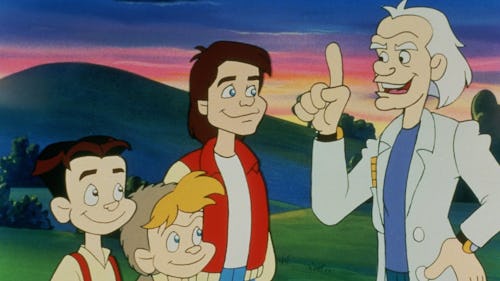
The end of Back to the Future III was the greatest unresolved cliffhanger in all of popular sci-fi. Or was it? Although that film ended with Doc showing up in a new time machine built out of a train, the adventures that followed were never chronicled. Except, of course, they were! In a cartoon, many of us watched but can scarcely believe was real.
While the ending of Back to the Future III was widely considered to be a satisfying conclusion trilogy the open-mindedness of its final moments has led many to wonder, “What’s next?” While Universal Pictures has, thankfully, resisted the urge to make a fourth Back to the Future film, there have been several officially-licensed follow-ups that have explored what came after the third film’s somewhat cliffhanger ending, including a video game and several different comic books.
However, the very first stab at a sequel to the Back to the Future trilogy came in the form of an unusual, surprisingly-star-powered, somewhat-educational, Saturday morning cartoon on CBS, which debuted on September 14, 1991. And it’s wild! Or as Marty would say...heavy.
In honor of the strange and wonderful Back to the Future cartoon — which debuted 31 years ago — here’s a look at what was all about, complete with interviews, artwork, and insight n directly from the people behind-the-scenes who made it happen. Here, at last, is the untold story of the Back to the Future cartoon.
When this baby hits 88 miles-per-hour-you’re gonna see some...seriously appropriate words for children!
Back to the Future: The Animated Series — Explained
Back in the 1980s and 1990s, it was pretty standard procedure to take a successful film property and adapt it into a kids’ cartoon, sometimes regardless of whether or not kids could watch the original. Everything from Ace Ventura: Pet Detective to Rambo — and of course, Ghostbusters — were made into cartoons, so it was natural for Universal to try their hand at a Back to the Future animated series. To head up the show, they turned to the writing duo of John Ludin and John Loy, who had previously put together the Bill & Ted cartoon and Martin Short’s Ed Grimley cartoon.
Many of these movie-into-cartoon projects had little to nothing to do with their original creative team, but this wasn’t the case with Back to the Future. Universal had Bob Gale — the screenwriter of the films along with director Bob Zemeckis — executive produce the cartoon and give his approval, or disapproval, to Loy and Ludin’s work. “Bob Gale was super involved with the show and he could get things done that we couldn’t,” says Ludin.
To figure out how to adapt the films into a weekly half-hour TV show, Ludin says that he and Loy screened the films on the Universal lot, paying particular attention to where Part III left off. “The natural inclination was to make Marty the center of the show, but Judy Price, the vice president of CBS, wanted it to be super kid-friendly,” says Ludin. As a result, they looked to Doc’s kids, Jules and Verne, who had appeared at the end of the third film for just a few seconds.
“We developed three or four different ways to go with this series, but none seemed to be able to go beyond a few episodes except for the one based around the two kids,” Ludin explains. In the films, Doc and Marty had just been on a number of adventures spanning from 1885 to 2015, so it made little sense to have either of those characters suddenly become reckless with time travel, especially on a weekly basis. But with impulsive children, they could get into all kinds of trouble and it would be up to Doc and Marty to help them out of it.
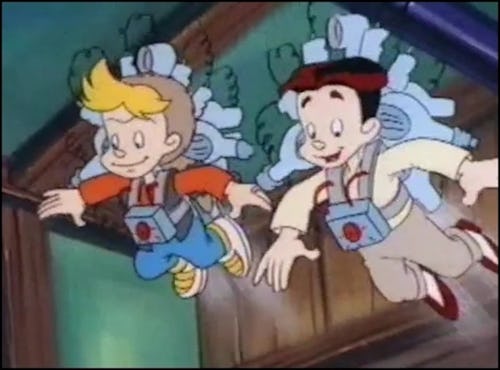
The children of the Future
Over a period of three months, Loy and Ludin developed the Jules-and-Verne-heavy approach to the series. “Jules and Verne had no character development in the films, so we made Jules into a miniature Doc and Verne into a Dennis the Menace-type character who could get into all kinds of trouble,” Ludin explains. They even crafted a pilot episode that saw the kids travel back to the Civil War and end up on opposing sides. (YIKES!)
But, when Bob Gale saw the script, he tossed it out, not liking the kid-heavy take. From there, Loy and Ludin went back to their other approaches. But, when they presented them to Gale, he saw the same limitations they did. That settled it, Jules and Verne would be the stars of the Back to the Future cartoon, not Doc and Marty.
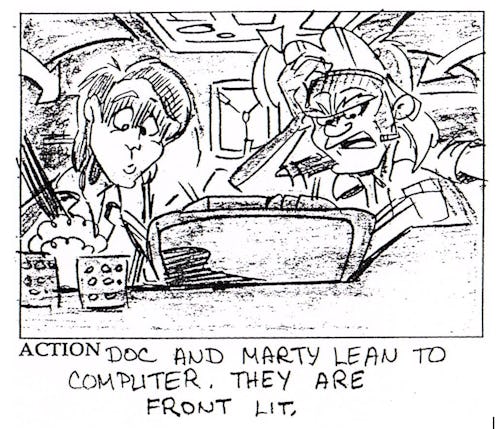
Doc and Marty, of course, would still be a huge part of the series and plenty of the 26 episodes produced would focus on them. In addition to that, Doc’s wife Clara would be a supporting character and, as for the villain, Biff Tannen and his many ancestors throughout history would be regular antagonists. “The censors allowed Biff to say one ‘Butthead’ per episode,” recalls Ludin.
For both Clara and Biff, the roles would be reprised by the same actors who played them in the trilogy, Mary Steenburgen and Tom Wilson. Voice actors Josh Keaton and Troy Davidson would fill the roles of Jules and Verne while Marty would be played by David Kaufman.
As for Doc Brown, the voice of Homer Simpson, Dan Castellaneta, took over voicing duties, but, in yet another bit of surprising star power for a Saturday morning cartoon, Christopher Lloyd did return to play Doc in live-action segments of the show. “Bob Gale was really into science and he’d loved Mr. Wizard as a kid,” explains Ludin, “so we talked about having a science segment be a part of the show. We developed the idea of having Doc introduce each episode and at the end, having him do some sort of science experiment that related to the episode.”
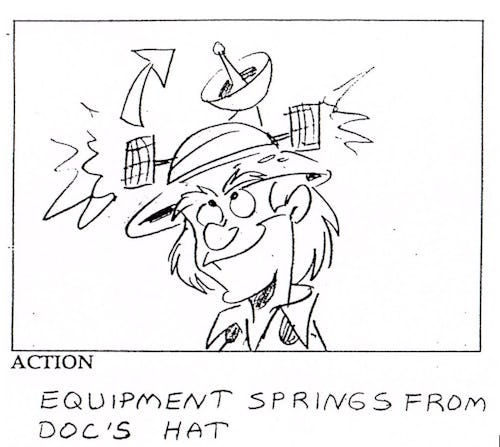
“There was only one problem with that,” says Ludin, “Christopher Lloyd is not a scientist and we were never going to be able to get him to make a battery with a lemon and crazy things like that, especially since our time with him was very limited.”
The invention of Bill Nye
To solve this problem, they gave Doc a lab assistant in the form of a young Bill Nye, an actor and mechanical engineer who Ludin knew from a local sketch show in Seattle named Almost Live. Ludin recalls, “I remember during the filming of his scenes, Bill would talk to me about this idea for a TV show he had where he’d do all kinds of experiments. ‘I’d call it Bill Nye the Science Guy,’ he used to tell me, and I just said ‘Okay Bill, good luck with that.’ It seemed like such an old-fashioned idea. — guess I missed out on that one.”
The live-action segments — which were filmed by future Ant-Man director Peyton Reed — took place in a laboratory set and some even featured the DeLorean, but they encompassed only a few minutes of each episode. Getting the cartoon right was the most important part and for the look of the series, Universal turned to Colossal Pictures, where artists James S. Baker and future Kung Fu Panda director John Stevenson turned the Back to the Future cast into cartoon characters.
The Return of the DeLorean
Artist Ken Mitchroney, who was a storyboard artist on several episodes of the series, says, “The character designs on this show were really great. For Doc and Marty especially, there was such strong design work, they just captured them perfectly. I only boarded a few episodes, but it was a thrill because I’m a huge Zemeckis fan and I'm a car guy, so to get to draw the DeLorean was particularly cool!”
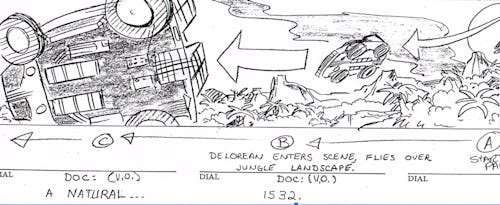
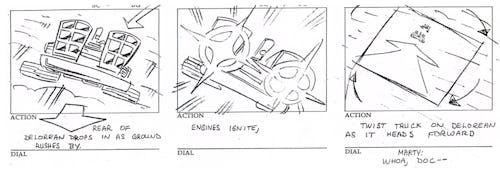
Indeed, while the DeLorean was destroyed at the end of the third movie, it was wisely brought back for the series and it could now collapse to the size of a suitcase. Besides the scientific impossibility of that — and, of course, all the ridiculous time travel stuff — Ludin explains that scientific and historical accuracy were really important to the series. “We wanted an educational element to the show, which is why the science segments were in it and, in keeping with that, we wanted historical accuracy too. We didn’t have them go back and meet famous people or interfere with events that kids could go look up for themselves. The one time we kind of cheated on that was an episode with Ben Franklin, who was just kind of irresistible for us to use.”
The end of the Future
CBS premiered the show on September 14, 1991 with a two-season, 26-episode commitment. There was also a set of McDonald’s Happy Meal toys released to promote the show. Ludin recalls a party held for the premiere where both Bob Zemeckis and executive producer Stephen Spielberg attended to celebrate a successful premiere. And, just a few weeks later, Mitchroney says, “Spielberg sent all of us on the show a letter saying how much he was enjoying it. I still have it.”
However, despite the name recognition of the show itself and several of its stars, the show never did great in the ratings. Ludin explains that “Many people, without even looking at it, considered it a cash-grab because it was based on a movie, regardless of how good it was or how much work we put into it.” In addition to that, according to modern reviews of the series, it seems that many Back to the Future fans didn’t care for the Jules and Verne-centric approach.

While CBS honored its commitment to a second season, the budget was slashed heading into Season Two, hurting the production value. “That took a lot of the steam out of the project,” laments Ludin. On December 26, 1992, the final episode of the Back to the Future cartoon aired, with CBS citing low ratings as the reason for its lack of renewal.
Still, for a show that only lasted two short seasons, it’s had a somewhat impressive afterlife. In addition to several home video releases, the show had a brief revival on Fox in 2003, where all the episodes were aired as part of their Saturday morning lineup. And, along with the aforementioned Happy Meal toys, the collector company NECA released toys of the series in 2020.
No doubt, the reason for the show’s outsized legacy has to do with it being a part of Back to the Future history more generally, as the movie continues to endure as a classic. Still, a lot of thought and care and some pretty great design work went into this cartoon series, so it survives on some of its own merits as well. Perhaps if the show had found a way to be more Doc and Marty-centric, it would have been more of what audiences were expecting and maybe even a bigger success. Unfortunately, there’s just no way to know that — unless, of course, someone manages to invent a real flux capacitor one day.
Back to the Future: The Animated Series is not currently streaming. You can watch it by snagging the DVDs.
